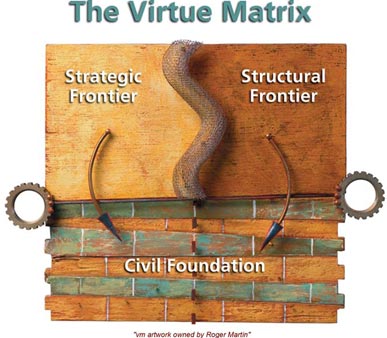"Choice" quadrant. In it are socially responsible activities in which other corporations in the environment are already engaging that a given corporation has a choice to match or eschew. In my view, a good corporate citizen attempts to engage in these activities at a high and thorough level compared to other like corporations in the environment. The two top quadrants comprise the "Frontier". In the Frontier are potential activities not currently engaged in by anybody but that would have the potential of making the world a better place. The upper left quadrant is the "Strategic Frontier". In the Strategic Frontier, a corporation can engage in an activity
that makes the world a better place and at the same time, turns out to be economically viable or attractive for the corporation. The upper right quadrant is the "Structural Frontier" where the corporation may engage in a practice that makes the world a better place, but it is economically unattractive—that is, no one rewards
the corporation for these practices, so they are uneconomic in the long run.
Corporations, therefore, can and should engage alone in ventures in the Strategic Frontier and if successful, those practices will be copied by others and eventually become part of an enriched Civil Foundation. In the Structural Frontier, corporations need to work in concert with other likecorporations
and/or governments to bring about change because otherwise Structural Frontier activities will be uneconomical and won't be sustained.
I am pleased to see that the Virtue Matrix is as helpful to corporations today as it was five years ago when I developed it. Recently we have
helped large corporations in Canada and, the US developed Virtue Matrix strategies to define their approaches to CSR.

